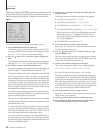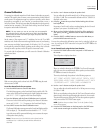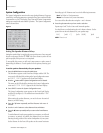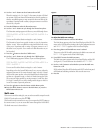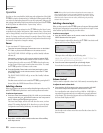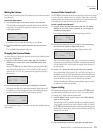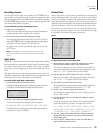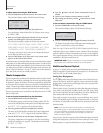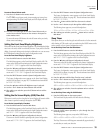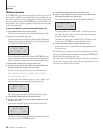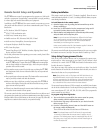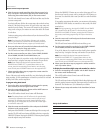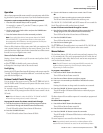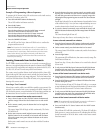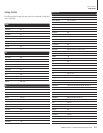
Sherbourn Technologies, Inc.
Owner’s Manual
35
Mde 950 7.1 Chae Pea/Pce
Owner’s Manual
To adjust channel trim using the TRIM function:
1. Press the TRIM button on the front panel or the remote control.
The Front Panel Display and the OSD will show the following:
CHANNEL TRIM
LEFT FRONT : 0dB
2. Use the < and > buttons to adjust the channel trim level.
You can adjust the selected channel level in 1dB steps across a range
of-15dB to +10dB.
3. When you are nished adjusting the Channel Trim for the selected
speaker, press TRIM again to cycle to the next channel.
The unit cycles through the speakers in the following sequence:
LEFT FRONTCENTER FRONTRIGHT FRONT RIGHT
SURR(OUND)RIGHT BACK (SURROUND)LEFT BACK
(SURROUND)LEFT SURR(OUND)SUBWOOFER
If necessary, repeat steps 2 and 3 until you have adjusted the channel
trim of all the speakers in your system.
4. Press the TRIM button on the front panel or the remote control
again to exit the Channel Trim function.
Remember to return any channel(s) that you have trimmed back to the original
setting when you are done watching the particular program. If you nd you are
continually trimming the same channel(s) by the same amount for every lm,
you might want to consider re-calibrating the speaker levels as shown in the
section, “Channel Calibration” on page 27. Set the levels for the channel(s)
up or down by the amount you normally trim them.
Theater Compensation
Theater Compensation provides special equalization within any of the selected
DSP modes. Most theatrical soundtracks are mixed on large dubbing stages
for playback in large movie theaters. When these soundtracks are played back
in your home, they may appear to have too much treble, sounding harsh and
“bright.” Theater Compensation modies the audio signal to reduce these char-
acteristics and make the soundtrack reproduction more natural sounding.
Theater Compensation can be accessed from the Main Menu or the T.COMP
button on the remote.
To turn on Theater Compensation from the Main Menu:
1. Press the MENU button to enter the Main Menu.
The Main Menu appears on the Front Panel Display and the OSD. The
cursor on the OSD should be pointing to the Input Conguration menu
and
INPUT CONFIG
appears on the Front Panel Display.
2. Press the button until System Conguration is selected.
The cursor on the OSD should be pointing to the System Conguration
menu and
SYSTEM CONFIG
appears on the Front Panel Display.
3. Press the SELECT button to enter the System Conguration menu.
The System Conguration menu appears on the Front Panel Display
and the OSD (see gure 4 on page 28). The selected menu item should
be
FRONT DISTANCE
.
4. Press the button until the Theater Compensation menu is
selected.
5. Use the < and > buttons to choose between On and Off.
6. After making your selection, press the button twice to exit the
Main Menu.
To turn on Theater Compensation using the T.COMP button:
1. Press the T.COMP button on the remote control.
The Front Panel Display and the OSD will show the following:
DVD DOLBY D
THEATER COMPEN:ON
2. Press the T.COMP button again to toggle the between On and Off.
The Theater Compensation menu will disappear automatically approxi-
mately 15 seconds after you make your selection.
Dolby Pro Logic II Cinema and DTS ES NEO:6 Cinema include a form of
equalization of their own to address the same conditions. When using these
modes the addition of Theater Compensation may cause excessive reduction
of the upper frequencies. However, you may wish to experiment with different
soundtracks to nd what sounds best to you.
IMPORTANT NOTE: Theater Compensation is not recommended for
Music modes, as the equalization added is not normally needed.
Multichannel Source Playback
Access to a 5.1 channel source connected to the Multichannel Inputs is accom-
plished by using the 6 Channel Direct mode. Examples of a 5.1 channel source
would be a DVD-A or SACD multi-channel player.
Analog Bass Management
The PT-7000 provides Analog Bass Management when 6 Channel Direct is
selected. This function, which only applies to a source connected to the Multi-
channel inputs, is controlled via a small toggle switch on the rear panel of the
PT-7000 (see item 18 on page 9).
When the switch is in the Up position, the Analog Bass Management function
is On, and the unit will provide an 80Hz crossover for the Left, Center, Right,
Left Surround and Right Surround loudspeakers. Bass below 80Hz from all
these channels will be sent into the subwoofer (.1) channel.
If the switch is set in the Down position, no crossover ltering occurs, provid-
ing the full bandwidth signal, including all bass information, to the speak-
ers. However, all information below 80Hz is still be summed and sent to the
subwoofer output.
Note: Since in the Off position bass information is not removed from
the speakers outpus, it is recommended that, unless you are absolutely
sure your loudspeakers can handle the low frequency information, or
that this function is supplied within your DVD player, you leave this
switch in the Up/On position.
Once you have connected a component to the Multichannel inputs and set the
Analog Bass Management, you should never have to change it, unless you get
different speakers or a player that includes its own bass management.
Operation
34



